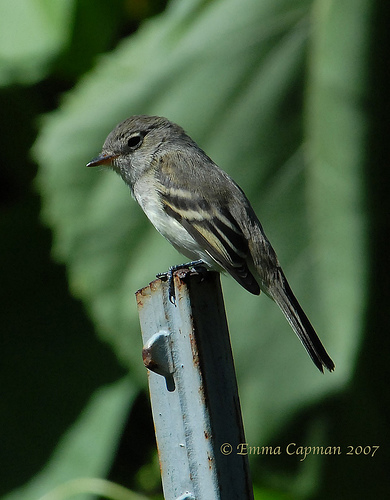Augsburg College and the nearby neighborhoods are very close to the Mississippi River, and the forests and other natural habitats along the river attract a great variety of birds. During the Spring and Fall migrations, the variety of birds along the river and in the surrounding areas can be particularly impressive, and birds can show up in places where you would not normally see them.
Though some species of flycatchers spend their summers in Minnesota, these birds are not usual residents of my family's Minneapolis backyard. However, this migrating bird spent most of the afternoon in our yard one warm September day.
Named for their habit of catching insects out of the air, flycatchers frequently sit up on perches scanning the area around them for flying insects. When they spot an insect, they drop off their perch to fly after the insect. They then frequently return to the same perch to watch for more insects.
This flycatcher found a post in our yard to be a convenient spot from which to survey the garden for insects.

Species identification can be difficult with these flycatchers. The five species of flycatchers in the genus Empidonax that breed in and migrate through Minnesota are readily distinguished during the breeding season by their songs, habitat choices, and nesting habits, but they don't normally sing during migration, and it is very difficult to distinguish these species based on appearance alone (Peterson 1980). Thus, the best I am able to do is say that the bird in these photos is an Empidonax flycatcher.
Birds that can find food in the North year-round normally do not migrate, but flying insects are not active once the temperatures drop. Therefore, these flycatchers migrate to warmer climates before our weather gets cold, and reside in Central and South America during our northern winters.
Migrating birds such as flycatchers, warblers, orioles, tanagers, swallows, and many others are very real and tangible links between Minnesota and the tropics. In both their summer breeding grounds and in their wintering grounds, these birds are important parts of the ecosystems in which they live. Thus, habitat destruction in the North that disrupts breeding grounds has effects that influence the tropics, and habitat destruction in the tropics that interferes with the birds' overwintering can have effects on Minnestota and the rest of northern North America.
Click for more information about Empidonax flycatchers
Click here for a previous Photo of the Month story on migrating birds
Reference:
Peterson, R. T. 1980. A Field Guide to the Birds East of the Rockies. Houghton Mifflin, Boston

